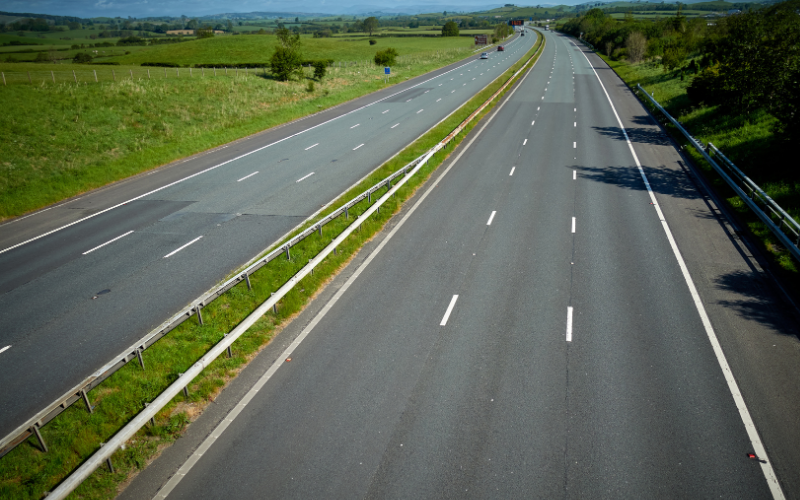Lockdown and UK Traffic Levels: Taking a Trip Through the Decades

On March 16th 2020, the UK announced an immediate lockdown in response to the coronavirus pandemic.
The way we lived changed overnight. Schools were shut, businesses were closed and we were all told to stay at home, only to venture out for essentials and one significant change that happened was the amount of traffic on our roads.
UK traffic levels on 1st March 2020 was recorded at 104%*. This dropped to 89%* on the first day of the lockdown (March 17th 2020) and would significantly decrease in the following months.
Let’s explore further to discover what decades the traffic levels throughout the lockdown related to:
April 2020
In April 2020, UK traffic levels were recorded at its lowest, with the percentage of vehicles on the road dropping to as little as 23%*. This portrayed similar levels to the decade that brought us Rock n Roll, Teddy Boy fashion and Tolkien’s final publication of the Lord of the Rings trilogy – The Return of the King.
But can you guess the decade?
Yes! That’s right, we’re travelling back to the 1950s.
The 1950s saw significant change for motoring. Zebra Crossings were introduced in 1951 and the price for the driving test doubled from 10 shillings (50p) to a £1... can you believe how cheap it used to be?!
Motorways also made an appearance in 1958, with the Preston Bypass being the first section of a motorway to be built, which has become part of the M6 today.
As for car models, the 1959 Mini and 1952 Land Rover were popular models that you’d find driving along UK roads in the 50s, and two-seater designs and open-topped cars were iconic automobile features of this decade.
May 2020
In May, we journeyed 20 years ahead as traffic levels increased slightly to 34%*.
After reviewing the traffic levels in May 2020, AA president, Edmund King, said that it was "akin to those in the early 1970s".
In the same decade that saw flares, platform shoes and funky disco tunes dominate the ‘peace and love’ era, there were only 13.5 million licensed vehicles on the road (there are a staggering 38.9 million licensed vehicles on the road today!) and the Ford Cortina and Vauxhall Viva ruled the roads.
Adjustments were made in May 1975 to the driving test when demonstrating arm signals was removed. Two years later, in 1977, extra checks were also added to MOTS, which included windscreen wipers, indicators, exhaust systems, body structure and chassis.
Although it could be argued that the space hopper was the greatest invention to come out of the 70s (how many hours of fun did they bring?!) car technology improved and the 8-track cassette player took the car audio world by storm! However, one questionable design element was the faux wood exterior decoration... were you a fan of this iconic 70’s car feature?
June 2020 – 1980/1990
As we came to the end of the 2020 lockdown, UK traffic levels rose to 63%* which, according to the AA, was similar to levels experienced in the late 1980s and early 1990s.
But what was so iconic about these two decades regarding the automotive world?
Well, whilst the legwarmers and crimpers were being packed away and we began to feel the pain Gazza felt as England were kicked out of the Italia 90 World cup, safety became an important factor within the automotive industry.
It became law in 1983 to wear a seatbelt and, in 1996, the Theory Test was introduced to help improve driving skills to ensure a safer driver.
The Ford Escort and Vauxhall Astra were popular 80’s models, but the only 90’s rivalry on par with the Oasis and Blur feud was the decision of which 90’s model you’d pick... the Renault Clio or the Ford Fiesta.
Finally, the 80s and 90s gave us some pretty iconic (although, arguably pointless) car features. Headlights had their very own wipers (yes, we’re still trying to figure out the benefit of these, too) and velour was a popular choice for interior material!
Public Transport
Another significant change was the use of public transport during the lockdown.
During the 3-month lockdown, public transport levels dropped dramatically, with the use of trains dropping to 4%, the London Tube dropping to as low as 3% and bus usage (excluding London) dropping to as little as 10%.
This dramatic decrease in the use of public transport comes as no surprise considering the government did advise people to walk or cycle wherever possible and only use public transport if necessary.
By the end of last year, a correlation between the increase in sales of cheaper used cars and the decrease in usage of public transport became apparent. Has lockdown encouraged more people to start driving?
Desire To Drive
From reliability and convenience to comfort and safety, in a post-pandemic world, it seems that more people have the desire to drive.
Whether you’re searching for your ideal used vehicle or would like to upgrade your current wheels to something new, we have something to fit all lifestyles and budgets:
Equally, if you’d like to learn more about hybrid and electric vehicles here at Bristol Street Motors, click the link below:
Learn More About Hybrid And Electric Vehicles
* percentage of the equivalent day in the first week of February 2020
Trains - Percentage of equivalent week in previous year
Tubes - Percentage of equivalent day in previous year
Buses - Percentage of equivalent day in the first week of march